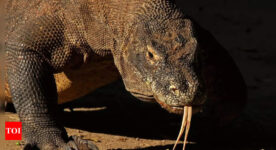
8 animals that reproduce without mating |
List of animals that have virgin births
Komodo Dragons
In 2006, scientists discovered that Komodo dragons (Varanus komodoensis), one of the deadliest reptiles in the world, could reproduce without males. At the time, a female Komodo dragon at Chester Zoo in the U.K. laid 25 eggs without having been in contact with any males. This was considered a marvel at the time.
Sharks
Bonnethead sharks (Sphyrna tiburo) are among the shark species known to reproduce via parthenogenesis. At Omaha’s Henry Doorly Zoo and Aquarium, a female bonnethead gave birth to a juvenile shark despite never having been exposed to males, leading to some very confused zoo keepers. This event confirmed that sharks could undergo parthenogenesis. Other shark species, including zebra sharks (Stegostoma tigrinum), blacktip reef sharks (Carcharhinus melanopterus), and smooth-hound sharks (Mustelus mustelus), have also exhibited virgin births.
California Condors
California condors (Gymnogyps californianus) are New World vultures and the largest land bird in North America. They can reproduce without males even when they are present. Genetic testing revealed that two male chicks born to a female condor in San Diego Zoo carried only their mother’s DNA.
Stick insects
Stick insects, particularly those in the genus Timema, predominantly reproduce through parthenogenesis. While asexual reproduction is common among these insects, it can limit their ability to adapt to changing environments. To counteract this, some Timema species occasionally engage in sexual reproduction, enhancing genetic diversity.
Blind snakes
The brahminy blind snake (Ramphotyphlops braminus) is a fascinating non-venomous species known for its unique reproductive strategy. Unlike most snakes, this species reproduces exclusively through parthenogenesis, a form of asexual reproduction where females produce offspring without the need for male fertilization. As a result, only female individuals have ever been observed in the wild. This remarkable adaptation allows the brahminy blind snake to colonize new environments efficiently, as a single individual can establish a new population. Found in various parts of the world, these tiny, burrowing snakes are often mistaken for earthworms due to their small size and lack of vision, but their reproductive strategy sets them apart as a unique example of nature’s diversity.
Tardigrades
Tardigrades, often referred to as water bears, are fascinating microscopic organisms known for their resilience and unique reproductive strategies. These tiny creatures can reproduce both sexually, involving the fusion of male and female gametes, and asexually through a process called parthenogenesis, where females produce offspring without fertilization. Interestingly, parthenogenesis is more prevalent in tardigrades inhabiting lake and terrestrial environments. This mode of reproduction allows them to rapidly increase their population in stable habitats where mates might be scarce. The ability to switch between sexual and asexual reproduction provides tardigrades with a remarkable adaptability, ensuring their survival in diverse and often extreme conditions. This reproductive flexibility, combined with their extraordinary ability to withstand harsh environments, makes tardigrades a subject of great interest in the scientific community.
Crocodiles
Crocodiles can reproduce without mating through a process known as parthenogenesis. This form of asexual reproduction allows embryos to develop from unfertilized eggs, without the need for male fertilisation. Although it is rare and was recently documented for the first time in crocodiles, parthenogenesis has been observed in other reptiles, such as some species of snakes and lizards. The discovery in crocodiles suggests that this ability might have existed in their ancient ancestors, potentially including dinosaurs and pterosaurs.
Mollyfish
Amazon mollies (Poecilia formosa) exhibit a unique form of parthenogenesis known as sperm-dependent parthenogenesis. These all-female fish use sperm from males of related species to trigger egg formation, though the sperm does not contribute genetic material to the egg.
Starfish
Starfish can reproduce both sexually and asexually. Asexual reproduction in some starfish is achieved through fission, which means that the organism will split into two to produce a new organism. This process is called Binary fission, where the cells of the parent organism divides into parts. During the process, the central disc present in the starfish breaks into two and each part regenerates the broken part. After a while, the arm of starfish detaches with the new disc and eventually a new organism is born.
Did you know?
Budding is also a form of asexual reproduction where a new organism grows from a certain part of the parent organism. The bud, once fully developed, detaches from the parent to become an independent organism. And another form of reproduction is Fragmentation, which occurs when an organism’s body is split into two or more parts, each of which regenerates into a complete organism. This process often involves regeneration, where the missing parts are regrown.
Did you like this article? Please let us know in the comments below!
Also Read | How do snakes mate? Reproduction, crossbreeding and interesting facts to know



